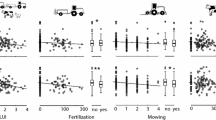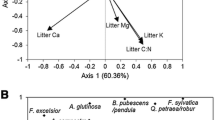Abstract
Massive human interference in natural ecosystems is resulting in a few “winners” and many “losers”. However, the drivers of this winner–loser replacement pattern remain poorly understood. The aim of the study reported here was to identify winners among the tree flora of Xishuangbanna and compare their functional traits, specific leaf area (SLA), wood density (WD), seed mass (SM) and maximum height (MH) with previously identified losers (i.e., endangered species). Fifteen native tree species were identified as winners from expert opinion, plot-based surveys of secondary forests and plotless surveys along roads. Twelve endangered tree species for which trait information could be obtained were used for comparison. Traits were compared with a Wilcoxon rank-sum test. Winners had significantly higher SLA, but lower WD. SM and MH did not differ significantly between groups. When the effects of phylogeny were removed by using phylogenetic generalized least squares, the difference in SLA became marginally insignificant. Principal component analysis resulted in two overlapping groups, showing that the selected traits were insufficient to distinguish winners and losers. Our results suggest that the “few winners, many losers” paradigm applies to trees in Xishuangbanna, with 15 species accounting for most trees in the disturbed habitats sampled.




Similar content being viewed by others
References
McKinney ML, Lockwood JL (1999) Biotic homogenization: a few winners replacing many losers in the next mass extinction. Trends Ecol Evol 14:450–453
Tabarelli M, Peres CA, Melo FPL (2012) The “few winners and many losers” paradigm revisited: emerging prospects for tropical forest biodiversity. Biol Conserv 155:136–140
Wiegmann SM, Waller DM (2006) Fifty years of change in northern upland forest understories: identity and traits of “winner” and “loser” plant species. Biol Conserv 129:109–123
Hanberry BB, Palik BJ, He HS (2013) Winning and losing tree species of reassembly in Minnesota’s mixed and broadleaf forests. PLoS One. doi:10.1371/journal.pone.0061709
Santos BA, Peres CA, Oliveira MA et al (2008) Drastic erosion in functional attributes of tree assemblages in Atlantic forest fragments of northeastern Brazil. Biol Conserv 141:249–260
Qian H, Guo Q (2010) Linking biotic homogenization to habitat type, invasiveness and growth form of naturalized alien plants in North America. Divers Distrib 16:119–125
Gurevitch J, Padilla DK (2004) Are invasive species a major cause of extinctions? Trends Ecol Evol 19:470–474
Hejda M (2013) Do species of invaded communities differ in their vulnerability to being eliminated by the dominant alien plants? Biol Invasions 15:1989–1999
Marques A, Costa C, Atman A et al (2014) Germination characteristics and seedbank of the alien species Leucaena leucocephala (Fabaceae) in Brazilian forest: ecological implications. Weed Res 54:576–583
Trentanovi G, Lippe M, Sitzia T et al (2013) Biotic homogenization at the community scale: disentangling the roles of urbanization and plant invasion. Divers Distrib 19:738–748
Davidson AM, Jennions M, Nicotra AB (2011) Do invasive species show higher phenotypic plasticity than native species and if so, is it adaptive? A meta-analysis. Ecol Lett 14:419–431
Richardson DM, Rejmánek M (2011) Trees and shrubs as invasive alien species—A global review. Divers Distrib 17:788–809
Li H, Ma Y, Aide TM et al (2008) Past, present and future land-use in Xishuangbanna, China and the implications for carbon dynamics. Forest Ecol Manag 255:16–24
Lôbo D, Leão T, Melo FPL et al (2011) Forest fragmentation drives Atlantic forest of northeastern Brazil to biotic homogenization. Divers Distrib 17:287–296
Laurance WF, Delamônica P, Laurance SG et al (2000) Conservation: rainforest fragmentation kills big trees. Nature 404:836
D”Angelo SA, Andrade AC, Laurance SG et al (2004) Inferred causes of tree mortality in fragmented and intact Amazonian forests. J Trop Ecol 20:243–246
Olden JD, Rooney TP (2006) On defining and quantifying biotic homogenization. Glob Ecol Biogeogr 15:113–120
Bierregaard RO (2001) Lessons from Amazonia: the ecology and conservation of a fragmented forest. Yale University Press, New Haven
Stoner KE, Vulinec K, Wright SJ et al (2007) Hunting and plant community dynamics in tropical forests: a synthesis and future directions. Biotropica 39:385–392
Tabarelli M, Mantovani W, Peres CA (1999) Effects of habitat fragmentation on plant guild structure in the montane Atlantic forest of southeastern Brazil. Biol Conserv 91:119–127
Oliveira MA, Grillo AS, Tabarelli M (2004) Forest edge in the Brazilian Atlantic forest: drastic changes in tree species assemblages. Oryx 38:389–394
Michalski F, Nishi I, Peres CA (2007) Disturbance-Mediated drift in tree functional groups in Amazonian forest fragments. Biotropica 39:691–701
Laurance WF (2004) Forest–climate interactions in fragmented tropical landscapes. Phil Trans Ser B Biol Sci 359:345–352
Oliveira M, Santos A, Tabarelli M (2008) Profound impoverishment of the large-tree stand in a hyper-fragmented landscape of the Atlantic forest. For Ecol Manag 256:1910–1917
Laurance WF, Nascimento HE, Laurance SG et al (2006) Rapid decay of tree-community composition in Amazonian forest fragments. Proc Natl Acad Sci USA 103:19010–19014
Laurance WF, Nascimento HE, Laurance SG et al (2006) Rain forest fragmentation and the proliferation of successional trees. Ecology 87:469–482
Zhu H, Cao M, Hu H (2006) Geological history, flora, and vegetation of Xishuangbanna, Southern Yunnan, China. Biotropica 38:310–317
Zhu H (2012) Biogeographical divergence of the flora of Yunnan, southwestern China initiated by the uplift of Himalaya and extrusion of Indochina block. PLoS One. doi:10.1371/journal.pone.0045601
Liu JJ, Slik J (2014) Forest fragment spatial distribution matters for tropical tree conservation. Biol Conserv 171:99–106
Liu X, Swenson NG, Zhang J et al (2013) The environment and space, not phylogeny, determine trait dispersion in a subtropical forest. Funct Ecol 27:264–272
Xu J, Grumbine RE (2012) Landscape transformation through the use of ecological and socioeconomic indicators in Xishuangbanna, Southwest China, Mekong Region. Ecol Indic 36:749–756
Wright IJ, Reich PB, Westoby M et al (2004) The worldwide leaf economics spectrum. Nature 428:821–827
Poorter L, Wright SJ, Paz H et al (2008) Are functional traits good predictors of demographic rates? Evidence from five Neotropical forests. Ecology 89:1908–1920
Paz H, Mazer S, Martinez-Ramos M (2005) Comparative ecology of seed mass in Psychotria (Rubiaceae): within-and between-species effects of seed mass on early performance. Funct Ecol 19:707–718
Pérez-Harguindeguy N, Díaz S, Garnier E et al (2013) New handbook for standardised measurement of plant functional traits worldwide. Aust J Bot 61:167–234
Abràmoff MD, Magalhães PJ, Ram SJ (2004) Image processing with ImageJ. Biophotonics Intern 11:36–42
Yang J, Zhang G, Ci X et al (2013) Functional and phylogenetic assembly in a Chinese tropical tree community across size classes, spatial scales and habitats. Funct Ecol 28:520–529
Doyle JJ (1987) A rapid DNA isolation procedure for small quantities of fresh leaf tissue. Phytochem Bull 19:11–15
Dong W, Cheng T, Li C et al (2014) Discriminating plants using the DNA barcode rbcLb: an appraisal based on a large data set. Mol Ecol Resour 14:336–343
Aiyar A (1999) The use of CLUSTAL W and CLUSTAL X for multiple sequence alignment, vol 132. Humana Press, New York, pp 221–241
Keane TM, Creevey CJ, Pentony MM et al (2006) Assessment of methods for amino acid matrix selection and their use on empirical data shows that ad hoc assumptions for choice of matrix are not justified. BMC Evol Biol 6:29
Tamura K, Peterson D, Peterson N et al (2011) MEGA5: molecular evolutionary genetics analysis using maximum likelihood, evolutionary distance, and maximum parsimony methods. Mol Biol Evol 28:2731–2739
Corlett RT, Xing F, Ng SC et al (2000) Hong Kong vascular plants: distribution and status. Mem Hong Kong Nat Hist Soc 23:1–157
King D, Davies S, Supardi MN et al (2005) Tree growth is related to light interception and wood density in two mixed dipterocarp forests of Malaysia. Funct Ecol 19:445–453
Tabarelli M, Aguiar AV, Girao LC et al (2010) Effects of pioneer tree species hyperabundance on forest fragments in northeastern Brazil. Conserv Biol 24:1654–1663
Tyree MT (2003) Hydraulic limits on tree performance: transpiration, carbon gain and growth of trees. Trees 17:95–100
Zenglai X (2004) Numerical analysis of the Euphorbiaceae. J Trop Subtrop Bot 12:399–404
Ghazoul J, Sheil D (2010) Tropical rain forest ecology, diversity, and conservation. Oxford University Press, Oxford
Van Gelder H, Poorter L, Sterck F (2006) Wood mechanics, allometry, and life-history variation in a tropical rain forest tree community. New Phytol 171:367–378
Kolb A, Diekmann M (2005) Effects of life-history traits on responses of plant species to forest fragmentation. Conserv Biol 19:929–938
Terborgh J, Robinson SK, Parker TA III et al (1990) Structure and organization of an Amazonian forest bird community. Ecol Monogr 60:213–238
Acknowledgments
This work was supported by the 1000 Talents Program (WQ20110491035). We are grateful to Hua Zhu, Guo-Da Tao, Jian-Wu Li, Jian-Tao Yin, Shi-Shun Zhou, Bin Wen and Qiang Liu for the assessment of the status of all angiosperms in Xishuangbanna. We thank Yu Song for his guidance with DNA extraction and phylogeny construction. We thank Kyle Tomlinson and Xiao Song for their advice with phylogeny analysis.
Conflict of interest
The authors declare that they have no conflict of interest.
Author information
Authors and Affiliations
Corresponding author
Electronic supplementary material
Below is the link to the electronic supplementary material.
About this article
Cite this article
Zhao, M., Pan, B., Tan, Y. et al. Winners and losers among tree species in Xishuangbanna: which traits are most important?. Sci. Bull. 60, 916–924 (2015). https://doi.org/10.1007/s11434-015-0799-7
Received:
Accepted:
Published:
Issue Date:
DOI: https://doi.org/10.1007/s11434-015-0799-7




